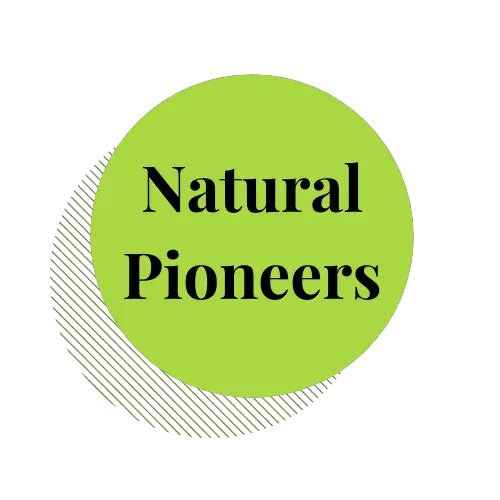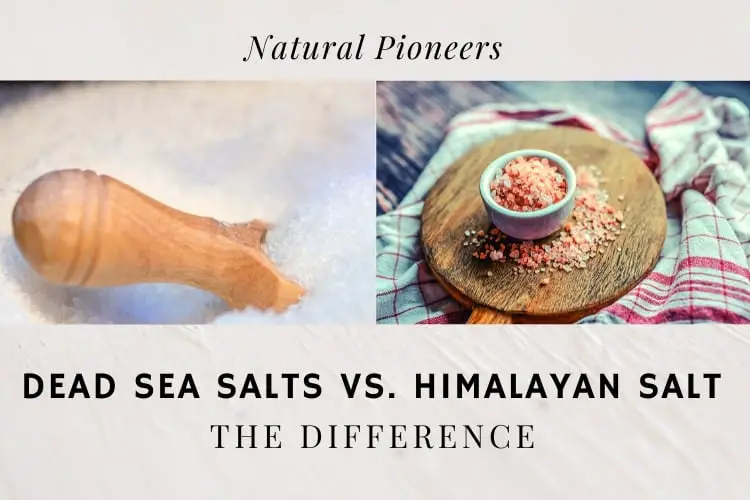
There is a lot of confusion about salt. Which one is edible, healthier, and best as a bath additive? This article will give you the answers you need.
Key differences between Himalayan & Dead Sea salts:
1. Himalayan salt is rock salt from Pakistan, Dead Sea minerals come from the Dead Sea.
2. Himalayan salt is edible, Dead Sea salt is not.
3. Himalayan salt is used as seasoning. Dead Sea bath salts & mud are used to treat skin diseases & arthritis.
Let’s start with Himalayan salt.
1. Himalayan Salt | Origin, Uses & Benefits
Edible salt has one of three main sources: the sea, a rock or underground salt sources. In Himalayan salt, we’re talking about a rock salt from Pakistan. The salt often has a pinkish tint due to mineral impurities.
Whereas table salt from underground sources is highly processed and usually contains added iodine, Himalayan salt (just like sea salt) are more untouched, natural sources that contain additional minerals.
Himalayan salt is often marketed as healthier due to its mineral content. It contains 84 natural minerals in total.
While we at Natural Pioneers definitely prefer more natural, less processed ingredients, we’re also curious whether the amount of minerals is significant enough to make Himalayan salt our go-to option when compared to other salts.
Pink Himalayan salt contains more calcium, potassium, magnesium and iron than table salt. Nevertheless, the amounts of these minerals in pink Himalayan – as in any other salt – are very, very small.
Based on the FDA’s recommendation, we should eat about 1 teaspoon of salt per day. This amount contains less than 1% of magnesium that we need on a daily basis.
Considering salt as a mineral supplier seems naive. The amount of minerals is so low that it’s practically impossible to meet daily requirements.
While certainly not a significant mineral supplier, Himalayan salt has 3 major attributes that make it superior to table salt.
- Himalayan salt is natural. Unlike table salt, it has not been refined or processed and doesn’t contain added ingredients like iodine and anticaking agents.
- Himalayan salt’s colorful appearance is perfect for use as a finishing salt where it can enhance the flavor of dishes and remain visible.
- Himalayan salt is more tasty! You’re likely to detect a noticeable difference in flavor compared to table salt. The contained minerals help dull the sharpness of pure sodium chloride. Many people prefer the flavor of Himalayan salt over other types.
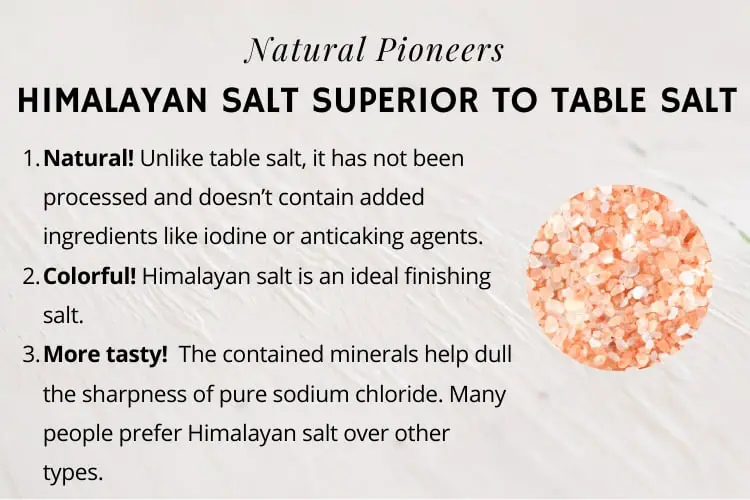
Studies prove that consumption of natural salt induces less hypertension compared to refined salt. [1]
But since the contained amount of minerals is small, many voices in the medical field don’t set great value upon switching from table salt to a slightly more nutritious Himalayan salt or sea salt. [2]; [3]
While we agree, that eating too much of any salt can be harmful, we definitely see more value in a natural product with a very small mineral amount than a highly-processed one like table salt. [4]
Take-away in foods: Himalayan salt is a more natural, tasty, colorful and more nutritional choice than highly-processed table salt. Himalayan salt seems to show equal health benefits to natural sea salt. Studies show that the consumption of natural salt induces less hypertension compared to refined table salt. Overall, both, rock salt (Himalayan salt) and sea salt show better nutritional profiles than refined table salt.
Himalayan salt is primarily used as a food additive, but is used in decorative salt lamps, and skin treatments as well.
Soaking in a bath with added Himalayan salt shows proven health benefits. The results seen in Himalayan salt skin treatments seem to match those of sea salt.
One study done with salt baths (1.5 cups of salt per bathtub) resulted in complete healing of all skin lesions and was more effective than other treatments. [5]
While this is a remarkable result and shows significantly better results than hot water alone, Dead Sea salt exceeds those health benefits. We’ll get to that next. So, how do you do a Himalayan salt bath?
How To Do A Himalayan Salt Bath:
- Start running warm water into a clean bathtub. Be sure it’s not too hot as hot water can aggravate inflamed skin and draw moisture from your skin.
- Add 1 cup of Himalayan salt under the running tap and mix with your hand until completely dissolved.
- Enjoy!
Curious about the best natural bath additives? Read more: What Is A Good Natural Bath Salt | Natural Bath Additives
Conclusion: The mineral composition in Himalayan salt shows higher amounts of minerals which make it a healthier option compared to highly-refined table salt. Sea salt and Himalayan salt seem to be of equally high quality based on current research. Studies show that baths in Himalayan salt are beneficial in wound healing.
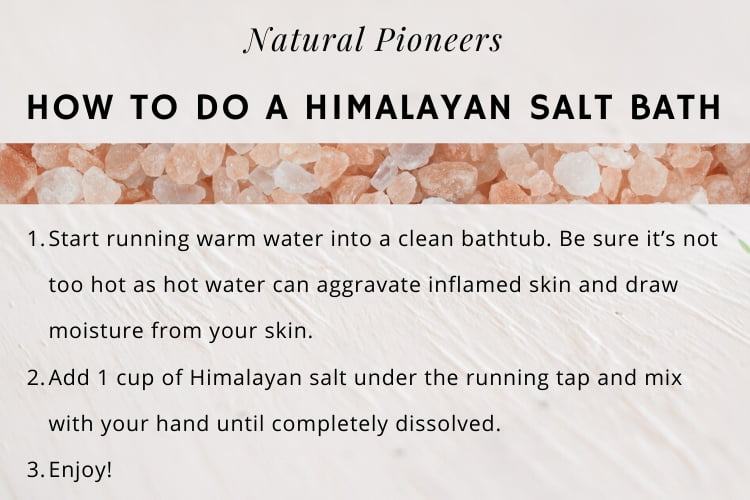
2. Dead Sea Salts | Origin, Uses & Benefits
The Dead Sea is a salt lake and the biggest natural saline reserve in the world. You’ll notice that we’re not talking about salt – but salts. Dead Sea salts are more than sodium.
Dead Sea salts consist of a complex mineral composition including large amounts of magnesium, sodium, calcium, potassium, bromine, chlorine, and smaller amounts of sulfate and bicarbonate.
It’s that very mineral composition that makes Dead Sea water unique.
Being made up of mostly magnesium and potassium (~60%), 8% salt and some rare minerals, Dead Sea salts are not safe for consumption and taste quite bitter.
Unlike Himalayan salt, Dead Sea salts are mainly used for topical treatments. Only a very small percentage of Dead Sea minerals are processed to edible salt.
In the medical field, Dead Sea salts and mud have shown to help with arthritis.
Their main use in cosmetic products, is to help with skin problems like stretch marks, acne, eczema, blemished skin, and aging signs. They can even cure eczema. And there is scientific proof that Dead Sea salts and mud work for all those conditions! [6]; [7]
With the shift towards more natural products, it’s no wonder that the global Dead Sea cosmetics market is booming and valued at a whooping USD 1.1 billion in 2018. [8]
Are Dead Sea minerals safe? Studies show that Dead Sea treatments have a good safety profile. The laboratory analysis of Dead Sea minerals reveals no mineral concentrations that could represent a health concern for their intended use. [9]
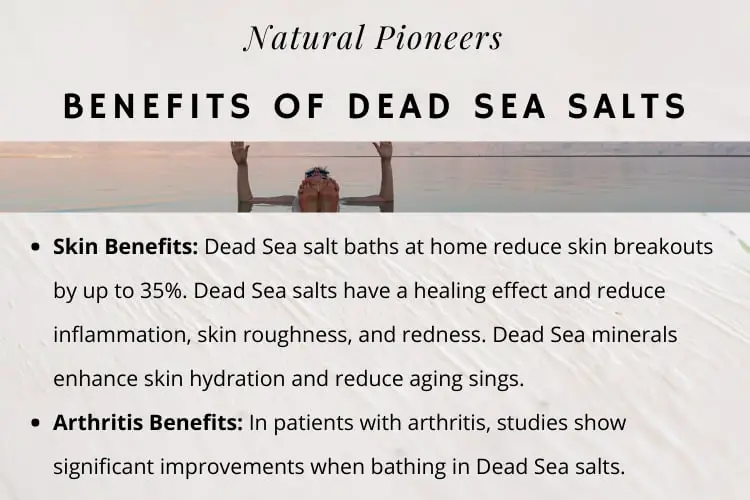
The main benefits of sea salt are seen were seen in studies that used 100% Dead Sea mud or Dead Sea salts. They were used as mud packages, masks and Dead Sea salt baths.
Dead Sea salts can help us in various ways:
- Dead Sea salt baths at home reduce skin breakouts by up to 35%. Dead Sea salts have a healing effect and reduce inflammation, skin roughness, and redness. [10]; [11]; [12]
- Dead Sea mineral baths restore moisture and enhance skin hydration. Dead Sea minerals contain a natural moisturizing factor that can improve the look of acne damaged skin. [13]
- Dead Sea baths reduce aging sings on human skin. Dead Sea minerals have a rejuvenating effect on your skin. [14]
- In rheumatoid arthritis patients, Dead Sea mud packs significantly improve morning stiffness, hand-grip strength and activities of daily living. [15]
- Dead Sea mud packs reduce pain severity in patients with chronic low back pain. [16]
- Dead Sea mud accelerates the wound healing process. [17]
- In patients with rheumatoid arthritis, daily baths in Dead Sea salts significantly improve morning stiffness, fifteen-meter walk time, hand-grip strength and circumference of joints. [18]
- Studies show Dead Sea spa therapy modalities help with psoriasis and psoriatic arthritis. [19]
- In patients with knee osteoarthritis, balneotherapy helps with pain, physical function and walking speed. [20]
- Up for a trip to the Middle East?
- Baths in the Dead Sea help with Fibromyalgia. Studies show a relief of symptoms (pain, fatigue, stiffness, and anxiety) and reduced frequency of symptoms (headache, sleep problems, and subjective joint swelling). [21]
- Intermittent balneotherapy in the Dead Sea helps with knee osteoarthritis. Results lasted up to 6 months. [22]
Curious about the effects of Dead Sea mud for blemished skin? Read more: Is Dead Sea Mud Good For Acne?
Make sure you use 100% Dead Sea salts with no added ingredients to achieve the same effects as seen in studies.
How To Do A Dead Sea Salt Bath:
- Start running warm water into a clean bathtub. Be sure it’s not too hot as hot water can aggravate inflamed skin and draw moisture from your skin.
- Add 1/2 cup of Dead Sea salts under the running tap and mix with your hand until completely dissolved. Dead Sea salts will leave a mud film on the tub – it wipes off easily.
- Enjoy!
Conclusion: Dead Sea salts are not safe for consumption and are mainly used for medical purposes to treat diseases. Dead Sea salt baths and mud prove to be beneficial to help with skin diseases like acne, psoriasis, redness, dry skin, and signs of aging. Dead Sea salts also help when treating arthritis. Dead Sea salts are considered safe according to laboratory analyses.
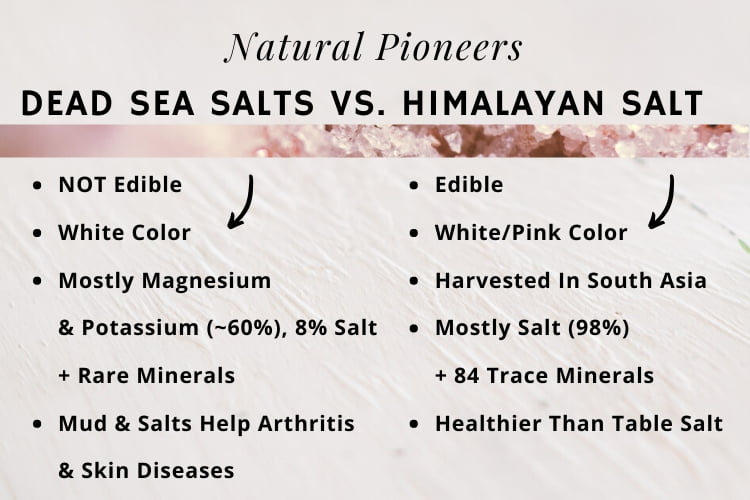
3. Himalayan And Dead Sea Salts | Differences
- Himalayan salt is edible, Dead Sea salt is not. Himalayan salt is rock salt that gets extracted in a Salt Mine near the Himalayas. It is one of the oldest salt mines. Unlike Himalayan salt, Dead Sea salts are mainly used for topical treatments. Dead Sea salts are mostly magnesium and potassium (~60%), 8% salt and some rare minerals. Dead Sea salts are not safe for consumption and taste quite bitter.
- Himalayan salt is from Pakistan, Dead Sea salt comes from the Dead Sea, a salt lake bordered by Jordan, Israel and Palestine.
- Himalayan salt comes in many colors. The color depends on what vein it was minded from. Colors range from white and pink, to orange, and red. Unwashed Dead Sea salts have a dirty, brown color. Washed Dead Sea salts are white.
- Himalayan and Dead Sea salt are used in different ways. Himalayan salt is primarily used as a food additive, but also found in decorative salt lamps, and used in skin treatments like bath salts. Dead Sea minerals are primarily used as Dead Sea mud (in masks or mud packages) or Dead Sea bath salt. They are also added to numerous cosmetic products. Make sure you use 100% Dead Sea salts or mud with no added ingredients to achieve the same effects as seen in studies.
- Himalayan salt and Dead Sea salts have a different mineral composition. The edible Himalayan salt contains 84 natural minerals in total. It’s more nutritious and natural than refined table salt. Inedible, Dead Sea salts are more than sodium. Dead Sea salts consist of a complex mineral composition including large amounts of magnesium, sodium, calcium, potassium, bromine, chlorine, and smaller amounts of sulfate and bicarbonate. Dead Sea salts are mostly magnesium and potassium (~60%), 8% salt and some rare minerals. Dead Sea salts are not safe for consumption and taste quite bitter.
- Studies show that Himalayan salt and Dead Sea salts have different health benefits:
- Himalayan:
- Studies prove that consumption of natural salt, like Himalayan salt, induces less hypertension compared to refined salt. [23]
- Soaking in a bath with added Himalayan salt has healing properties. One study done with about 1.5 cups of salt / bathtub resulted in complete healing of all skin lesions and was more effective than other treatments. [24]
- Dead Sea salts:
- Dead Sea salt baths at home reduce skin breakouts by up to 35%. Dead Sea salts have a healing effect and reduce inflammation, skin roughness, and redness. [25]; [26]; [27]
- Dead Sea mineral baths restore moisture and enhance skin hydration. Dead Sea minerals contain a natural moisturizing factor that can improve the look of acne damaged skin. [28]
- Dead Sea baths reduce aging sings on human skin. Dead Sea minerals have a rejuvenating effect on your skin. [29]
- In rheumatoid arthritis patients, Dead Sea mud packs significantly improve morning stiffness, hand-grip strength and activities of daily living. [30]
- Dead Sea mud packs reduce pain severity in patients with chronic low back pain. [31]
- Dead Sea mud accelerates the wound healing process. [32]
- In patients with rheumatoid arthritis, daily baths in Dead Sea salts significantly improve morning stiffness, fifteen-meter walk time, hand-grip strength and circumference of joints. [33]
- Studies show Dead Sea spa therapy modalities help with psoriasis and psoriatic arthritis. [34]
- Baths in the Dead Sea help with Fibromyalgia. Studies show a relief of symptoms (pain, fatigue, stiffness, and anxiety) and reduced frequency of symptoms (headache, sleep problems, and subjective joint swelling). [35]
- In patients with knee osteoarthritis, balneotherapy helps with pain, physical function and walking speed. [36]
- Intermittent balneotherapy in the Dead Sea helps with knee osteoarthritis. Results lasted up to 6 months. [37]
- Himalayan:
